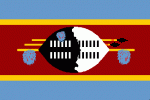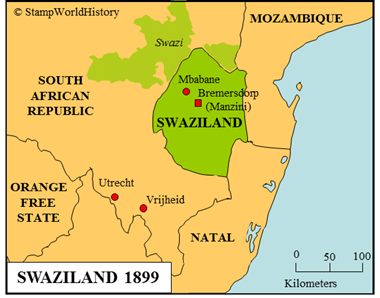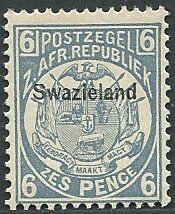
Swaziland
British protectorate

Swaziland
Kingdom
Quick reference
General issues: Kingdom 1889-1894, British protectorate 1933-1967, British protectorate, self government 1967-1968, Kingdom 1968-Present
Country name on general issues: Swazieland, Swaziland
Currency: 1 Pound = 20 Shilling, 1 Shilling = 12 Pence 1889-1894 and 1933-1961, 1 Rand = 100 Cent 1961-1975, 1 Lilangeni = 100 Cent 1975-Present
Population: 100 000 in 1911, 1 250 000 in 2013
Political history Swaziland
Swaziland is located in southern Africa. The kingdom of Swaziland is formed in the early 19th century from different peoples that subsequently blend to form the Swazi people. From the mid 19th century, Swaziland is confronted with the advance of the Boer establishing the South African Republic and the British establishing, and gradually expanding, the colony of Natal. Swaziland signs treaties with the Boer and the British in 1881 and 1884 respectively. These treaties secure the borders of Swaziland as a polity but grant both the Boer and the British substantial influence. Resources used differ about the extent of this influence: some suggest it concerns a number of economical concessions, such as the the right to own land, others suggest that Swaziland became a de facto condominium of the Boer and the British. In subsequent years, the Boer extend their influence, and in 1894 Swaziland becomes a protectorate of the South African Republic.
The Second Boer War, from 1899 to 1902, has its impact on Swaziland. The South African Republic is defeated and becomes the British colony of Transvaal. Swaziland now becomes a British protectorate, initially administered as part of Transvaal. In 1906, Swaziland becomes a de jure separate protectorate – one of High Commission Territories together with Basutoland and Bechuanaland. Although de jure a protectorate, Swaziland is de facto administered as a colony. As do Basutoland and Bechuanaland, Swaziland, in 1910, remains outside the Union of South Africa formed in that year. In 1967, Swaziland gains self government and in 1968 full independence as the kingdom of Swaziland.
Swaziland is an absolute monarchy. Talks about the introduction of a constitution have been on the agenda but have not led to lasting reforms. The economy largely depends on agriculture and remittances from Swazi working in South Africa.
Postal history Swaziland
The first stamps are issued for Swaziland in 1889. They reflect the influence of the South African Republic in Swaziland being stamps from the South African Republic overprinted ‘Swazieland’. When Swaziland, in 1894, becomes a protectorate of the South African Republic, the stamps of Swaziland are withdrawn, to be superseded by the issues of the South African Republic. During the Second Boer War, postal services come to a standstill. Having become a British protectorate in 1902, Swaziland will use the stamps of Transvaal and, from 1910, the stamps of the Union of South Africa.
Stamps are again issued for Swaziland from 1933 – many of the issues being of the designs common to the British colonies. These are, from 1967, followed by issues from the self governing Swaziland and, from 1968, from the kingdom of Swaziland. Most issues of Swaziland – in the British tradition – show the portrait of the king of Swaziland.
Album pages
← Previous page: SudanNext page: Tanganyika →




